Orthodontic Cases by Symptom > ORTHODONTIC TREATMENT
SEOUL DENTAL HOSPITAL
COSMETIC DENTISTRY AESTHETIC
IMPLANT
ORTHODONTIC TREATMENT
PREVENTIVE CARE & SLEEP APNEA
TMD & AETHETICS
CUSTOMER SERVICE
SEOUL DENTAL HOSPITAL
COSMETIC DENTISTRY AESTHETIC
IMPLANT
ORTHODONTIC TREATMENT
PREVENTIVE CARE & SLEEP APNEA
TMD & AETHETICS
CUSTOMER SERVICE
 Case of Deep Overbite 1
Case of Deep Overbite 1
Deep overbite is an abnormal occlusion where the upper front teeth cover the lower
front teeth more than normal. It can contribute to periodontal disease,
excessive force or damage to the teeth, and may be associated with bruxism and
temporomandibular joint disorders. Deep overbite often makes the midface
appear longer and can result in a square jaw due to the increased occlusal force
and excessive exposure of the upper anterior teeth.
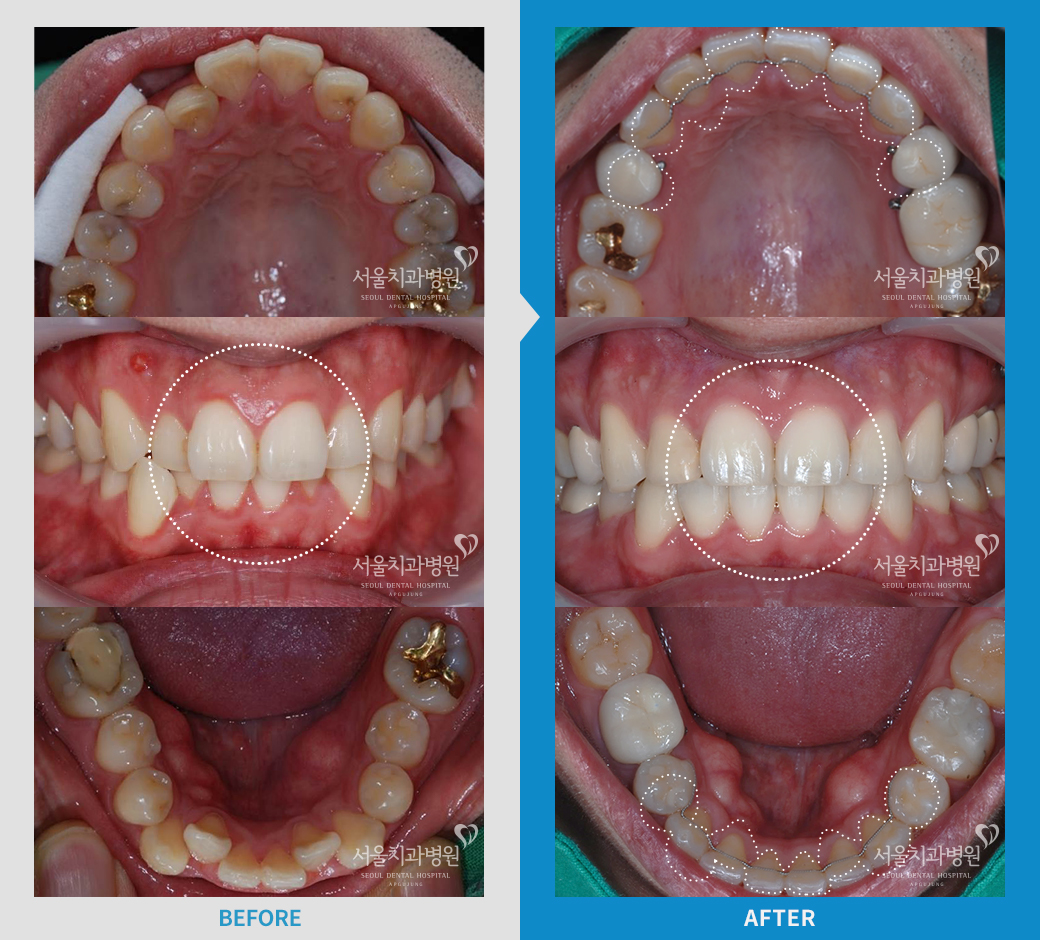
 Case of Deep Overbite 2
Case of Deep Overbite 2

 The patient visited due to overall periodontal disease and loss of the mandibular molars related to deep overbite,
requiring implant treatment. After periodontal treatment, the deep overbite was corrected, and implants were placed
in the mandibular molars following orthodontic treatment. Initial examination showed that gum inflammation
was caused by tooth overlap and excessive occlusal force, so the deep overbite was improved without extraction,
leading to the maintenance of healthy periodontal tissue afterward
The patient visited due to overall periodontal disease and loss of the mandibular molars related to deep overbite,
requiring implant treatment. After periodontal treatment, the deep overbite was corrected, and implants were placed
in the mandibular molars following orthodontic treatment. Initial examination showed that gum inflammation
was caused by tooth overlap and excessive occlusal force, so the deep overbite was improved without extraction,
leading to the maintenance of healthy periodontal tissue afterward
 Open Bite
Open Bite
Open bite refers to a type of malocclusion where there is a gap between
the upper and lower teeth when they are in a centered occlusion,
leading to a lack of contact between them and creating spaces between the teeth.

 In this case, the patient couldn't cut food as the upper and lower teeth did not touch,
and experienced dry mouth due to the inability to close the mouth properly.
The open bite was addressed using screws and molar instructions, establishing a normal dental occlusion
that allowed for cutting food effectively.
In this case, the patient couldn't cut food as the upper and lower teeth did not touch,
and experienced dry mouth due to the inability to close the mouth properly.
The open bite was addressed using screws and molar instructions, establishing a normal dental occlusion
that allowed for cutting food effectively.
 Non-Extraction Protruded Teeth Correction - 1
Non-Extraction Protruded Teeth Correction - 1
Protruded teeth refer to a condition where the gums and teeth extend
forward compared to the tip of the nose or chin when viewed from the side.
Correcting protruded teeth can not only change the facial contour
but also improve issues like nasolabial folds and a recessed chin,
resulting in a more refined appearance.

 This case involves a patient whose lower jaw was smaller compared to the upper jaw, and who had difficulty fully closing their lips.
This case involves a patient whose lower jaw was smaller compared to the upper jaw, and who had difficulty fully closing their lips.
 Non-Extraction Protruded Teeth Correction - 2
Non-Extraction Protruded Teeth Correction - 2
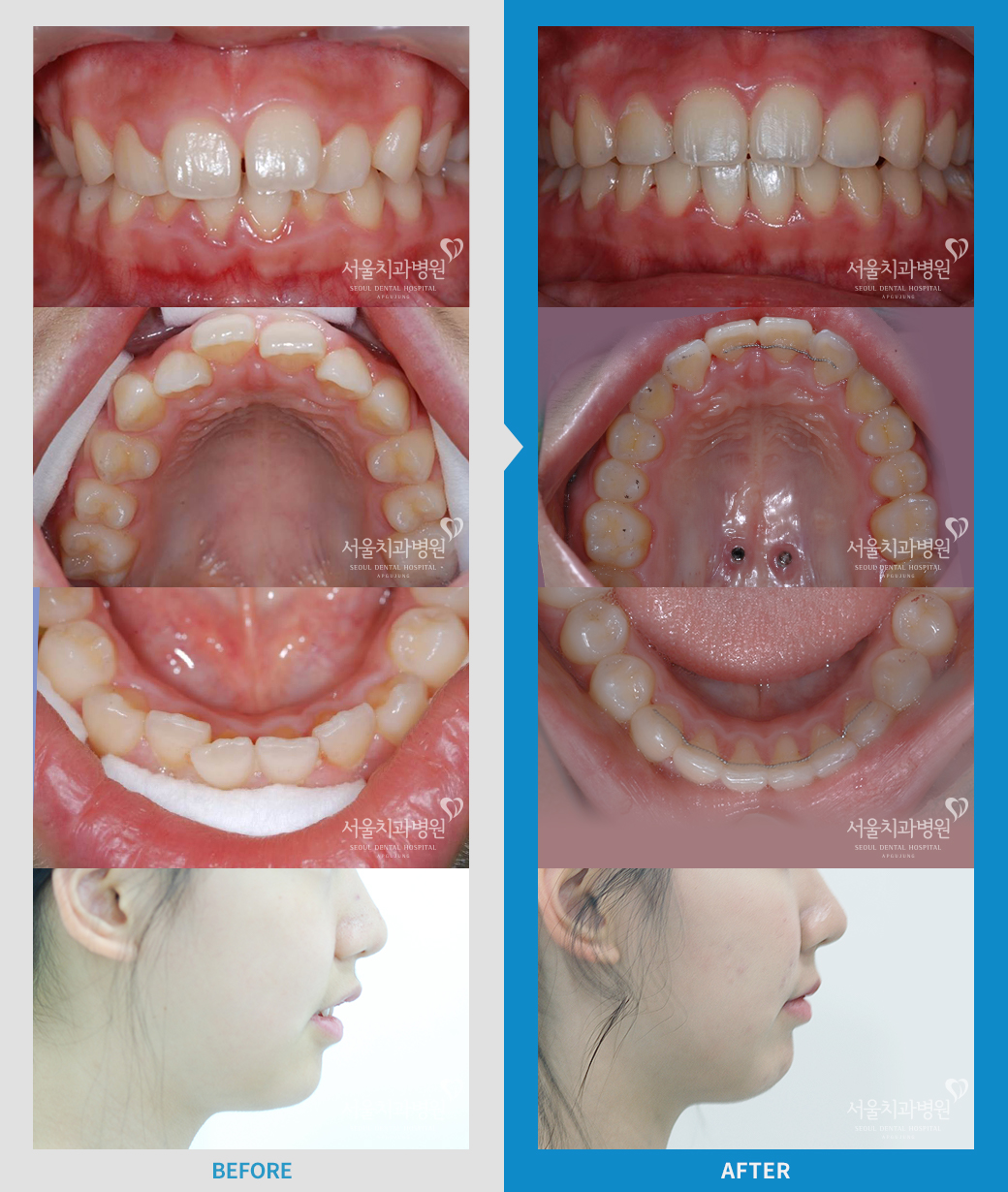
 After aligning the upper teeth ideally and then adjusting the lower teeth accordingly, proper occlusion was achieved.
As a result, the upper and lower lips could close, preventing the mouth from becoming dry,
and allowing the patient to breathe through their nose.
After aligning the upper teeth ideally and then adjusting the lower teeth accordingly, proper occlusion was achieved.
As a result, the upper and lower lips could close, preventing the mouth from becoming dry,
and allowing the patient to breathe through their nose.
 Extraction protrusion correction - 1
Extraction protrusion correction - 1

 This case involves a patient whose upper and lower jaws were protruded
at the initial consultation, causing the lips to stick out and deviate from the aesthetic line.
After extraction and protrusion correction, the patient achieved a straight profile
and harmonious facial proportions, regaining their confidence.
This case involves a patient whose upper and lower jaws were protruded
at the initial consultation, causing the lips to stick out and deviate from the aesthetic line.
After extraction and protrusion correction, the patient achieved a straight profile
and harmonious facial proportions, regaining their confidence.
 Extraction protrusion correction - 2
Extraction protrusion correction - 2
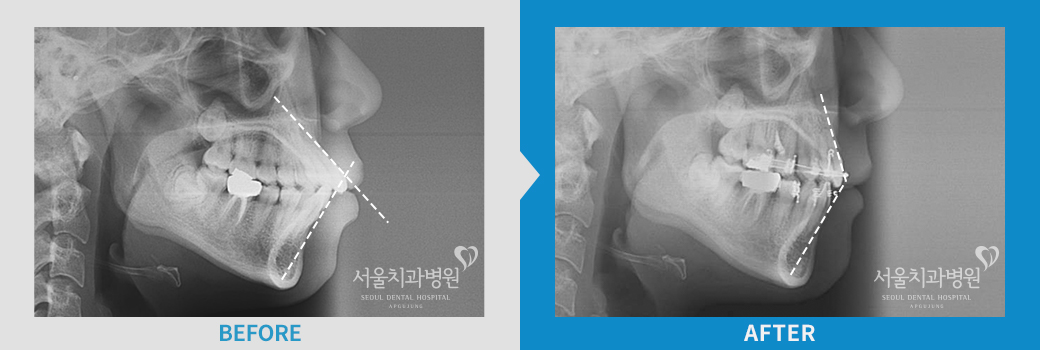
 This case involves a patient whose protruding upper and lower teeth prevented them from fully closing their mouth,
resulting in a dull appearance and lack of confidence.
After extraction and correction of the protrusion, the patient transformed into a more refined and neat appearance.
This case involves a patient whose protruding upper and lower teeth prevented them from fully closing their mouth,
resulting in a dull appearance and lack of confidence.
After extraction and correction of the protrusion, the patient transformed into a more refined and neat appearance.
 Crooked teeth correction
Crooked teeth correction
Crooked teeth occur when there isn’t enough space for the teeth to come in properly,
causing them to shift significantly to the side.
Food particles can easily get stuck between the teeth,
and brushing becomes difficult, increasing the risk of cavities.

 This case involves a patient with crooked teeth caused by a narrow dental arch,
resulting in insufficient space for proper tooth alignment.
The crooked teeth, which frequently led to cavities and periodontal disease,
were straightened, and the occlusion was improved, creating a healthier oral environment.
This case involves a patient with crooked teeth caused by a narrow dental arch,
resulting in insufficient space for proper tooth alignment.
The crooked teeth, which frequently led to cavities and periodontal disease,
were straightened, and the occlusion was improved, creating a healthier oral environment.
 Gap teeth correction - 2
Gap teeth correction - 2

 This case involves a patient whose protruding upper teeth created gaps.
By aligning the occlusal plane of the upper and lower jaws and improving the occlusal relationship,
the space between the teeth was reduced, and the upper front teeth were arranged neatly.
As a result, the lips could close properly, leading to aesthetic satisfaction and reducing food particles
trapped between the teeth, thereby promoting a healthier oral environment.
This case involves a patient whose protruding upper teeth created gaps.
By aligning the occlusal plane of the upper and lower jaws and improving the occlusal relationship,
the space between the teeth was reduced, and the upper front teeth were arranged neatly.
As a result, the lips could close properly, leading to aesthetic satisfaction and reducing food particles
trapped between the teeth, thereby promoting a healthier oral environment.
 Asymmetric correction of a misaligned plane
Asymmetric correction of a misaligned plane
This occurs when the entire dental arch is tilted relative to the lip line or face. It may not be due to
a tilted occlusal plane but could instead be caused by muscular or skeletal asymmetry,
necessitating an accurate diagnosis.
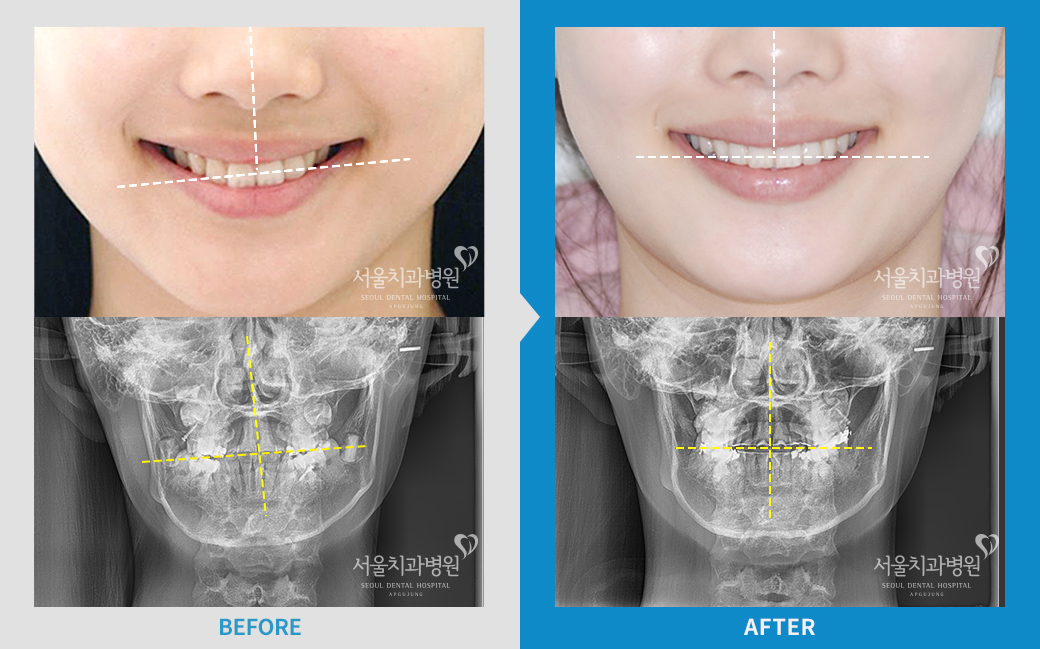
 This case involves a patient whose face appeared uneven, with one side drooping when smiling or speaking.
The occlusal plane on the right side, which was lowered, was raised, and the misalignment of the lips
and facial asymmetry were alleviated. Additionally, the lower jaw was rotated to match the elevated side,
effectively resolving the asymmetry.
This case involves a patient whose face appeared uneven, with one side drooping when smiling or speaking.
The occlusal plane on the right side, which was lowered, was raised, and the misalignment of the lips
and facial asymmetry were alleviated. Additionally, the lower jaw was rotated to match the elevated side,
effectively resolving the asymmetry.
 Correction of malocclusion due to microdontia
Correction of malocclusion due to microdontia
Crooked teeth occur when there isn’t enough space for the teeth to come in properly,
causing them to shift significantly to the side.
Food particles can easily get stuck between the teeth,
and brushing becomes difficult, increasing the risk of cavities.

 This case involves a patient with malocclusion caused by microdontia and missing teeth,
which led to gaps between the teeth that caused them to cover their mouth with their hand when smiling.
After arranging the teeth, fixed appliances were used to resolve the asymmetry.
Once the orthodontic treatment was completed, laminate veneers were applied to the small areas.
Following the treatment, the patient regained confidence with a bright smile.
This case involves a patient with malocclusion caused by microdontia and missing teeth,
which led to gaps between the teeth that caused them to cover their mouth with their hand when smiling.
After arranging the teeth, fixed appliances were used to resolve the asymmetry.
Once the orthodontic treatment was completed, laminate veneers were applied to the small areas.
Following the treatment, the patient regained confidence with a bright smile.
 Correction of prognathism without bimaxillary surgery
Correction of prognathism without bimaxillary surgery
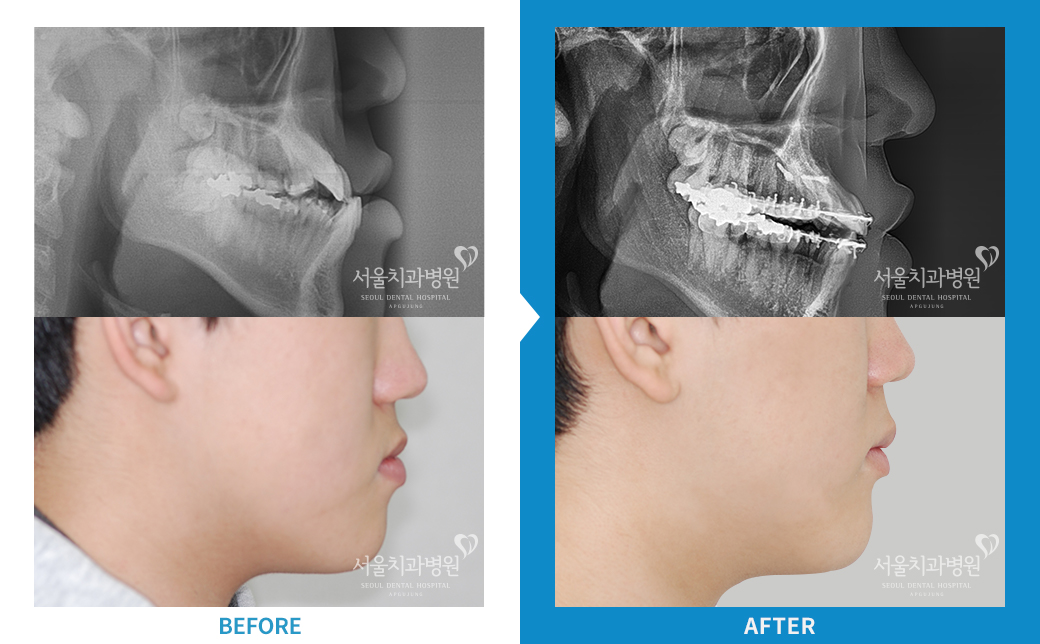
 In this case, an expansion device was used to widen the upper jaw, allowing it to cover the lower jaw.
The lower teeth were aligned by pulling them back and towards the rear. After correcting the alignment,
the upper jaw was advanced forward, and the lower jaw was retracted backward, achieving a harmonious
facial appearance without the need for bimaxillary surgery.
In this case, an expansion device was used to widen the upper jaw, allowing it to cover the lower jaw.
The lower teeth were aligned by pulling them back and towards the rear. After correcting the alignment,
the upper jaw was advanced forward, and the lower jaw was retracted backward, achieving a harmonious
facial appearance without the need for bimaxillary surgery.
 Permanent tooth loss
Permanent tooth loss
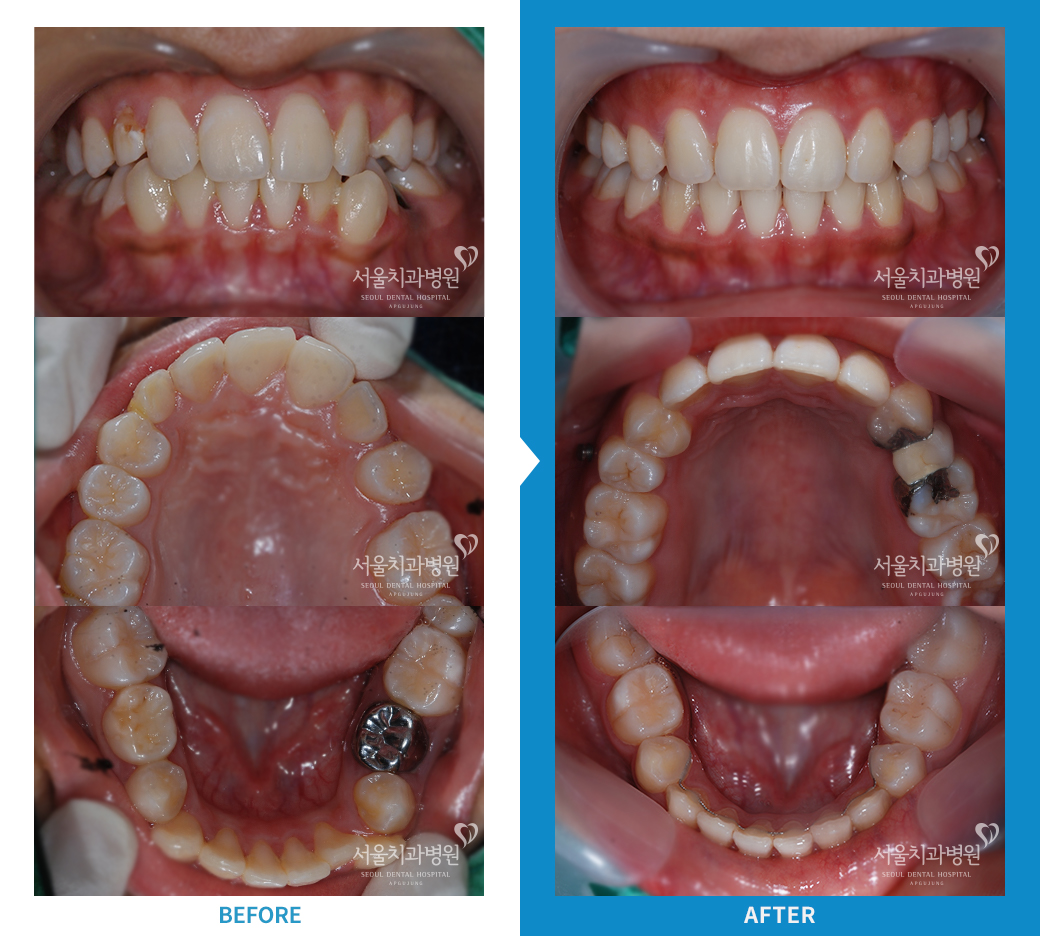
 In this case, the patient had congenital loss of the upper canine and lower premolars.
Instead of placing implants in the missing areas, the space was utilized to improve the occlusal relationship
and align the teeth along the midline. This approach resulted in enhanced profile aesthetics and improved masticatory function.
In this case, the patient had congenital loss of the upper canine and lower premolars.
Instead of placing implants in the missing areas, the space was utilized to improve the occlusal relationship
and align the teeth along the midline. This approach resulted in enhanced profile aesthetics and improved masticatory function.
 Permanent tooth loss - 2
Permanent tooth loss - 2
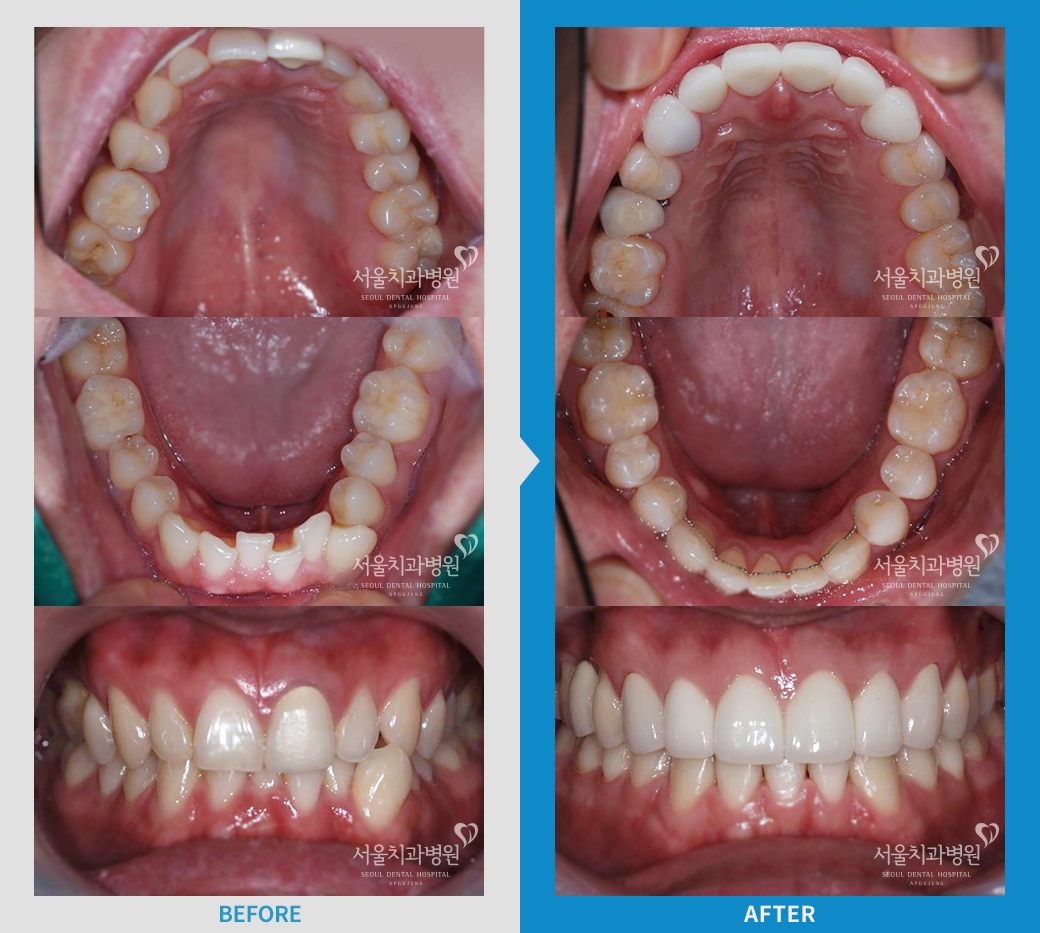
 When reverse occlusion occurs during growth, it can suppress the growth of the upper jaw
and create a sunken facial appearance. To address this, an expansion device and face mask are
actively used to adjust the growth direction, promoting the development of the upper jaw and the nasal bones.
When reverse occlusion occurs during growth, it can suppress the growth of the upper jaw
and create a sunken facial appearance. To address this, an expansion device and face mask are
actively used to adjust the growth direction, promoting the development of the upper jaw and the nasal bones.
| Seoul Dental Non-covered Services | ||
| Issuance Fee | General Medical Certificate | ₩20,000 |
| Injury Certificate (Less than 3 Weeks) |
₩100,000 | |
| Injury Certificate (3 Weeks or More) |
₩150,000 | |
| Medical Certificate | ₩30,000 | |
| Copy of Medical Records (1-5 Pages) |
₩1,000 | |
| Copy of Medical Records (More than 6 Pages)) |
₩100 | |
| Prosthetic Treatment | Gold Crown (45%) | ₩600,000-₩700,000 |
| PFM Crown | ₩650,000 | |
| Inlay | ₩350,000-₩450,000 | |
| Implant | Domestic | ₩1,200,000-₩1,800,000 |
| Imported | ₩2,000,000-₩3,000,000 | |
| Bone Grafting | ₩300,000-₩1,000,000 | |
| Maxillary Sinus Elevation Surgery | ₩500,000-₩1,500,000won | |
| Laser Scaling | ₩100,000 | |
| Preventive Treatment | Scaling (Non-covered) |
₩70,000 |
| Fluoride Application | ₩30,000-₩50,000 | |
| Orthodontics | Clear Aligners | ₩1,000,000-₩3,500,000 |
| Ceramic Braces | ₩6,000,000 | |
| Lingual Braces | ₩8,000,000-₩12,000,000 | |
| Conservation | Posterior Resin | ₩100,000 |
| Cervical Resin | ₩100,000-₩120,000 | |
| Anterior Resin | ₩150,000-₩200,000 | |
| Phase I Orthodontic Treatment | Appliance Fee | ₩600,000-₩1,500,000 |
| Partial Orthodontic Treatment | ₩1,000,000-₩2,000,000 | |
| Teeth Whitening | Laser Teeth Whitening | ₩250,000-₩700,000 |